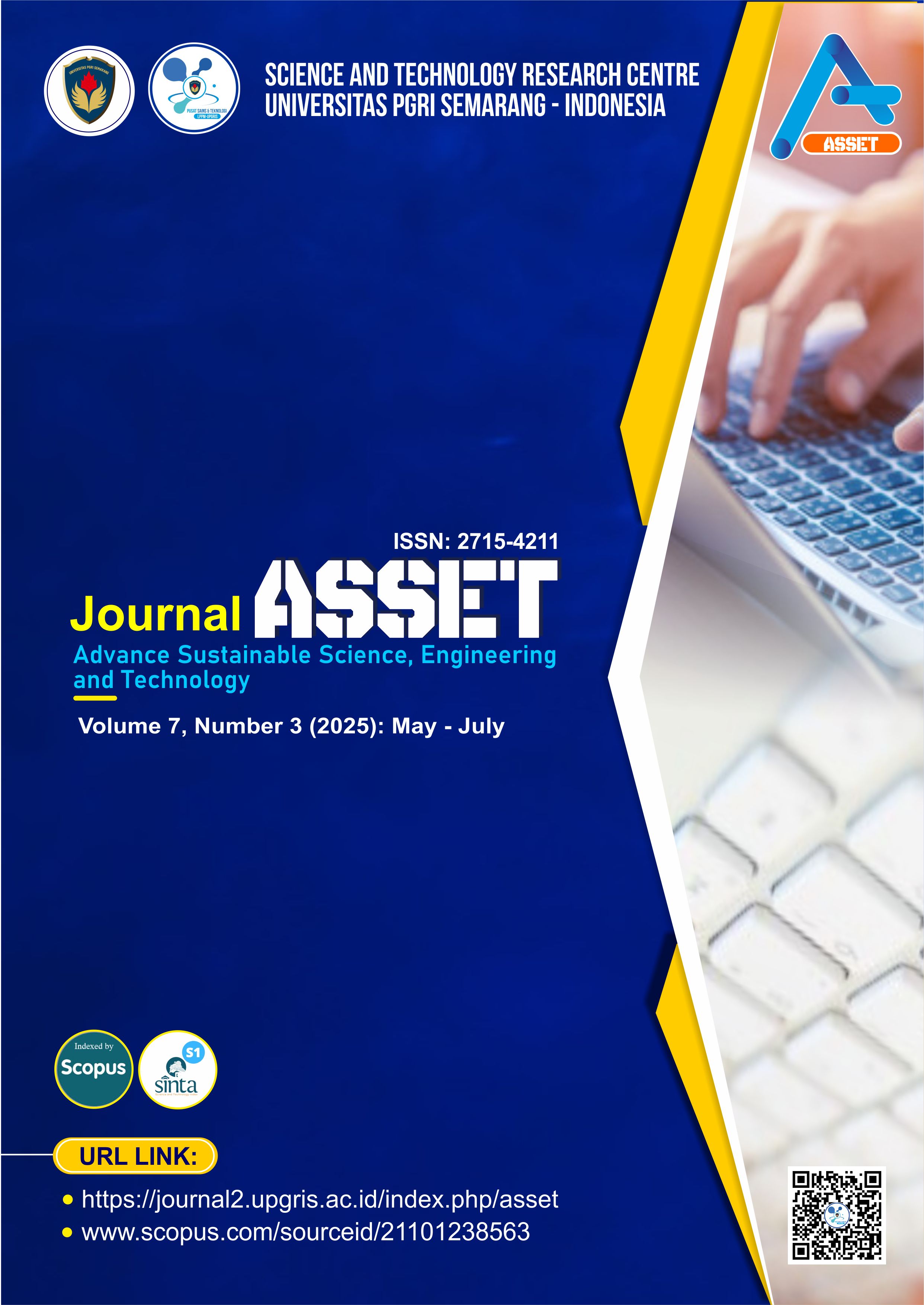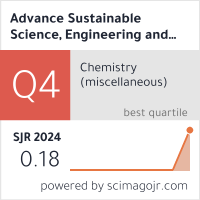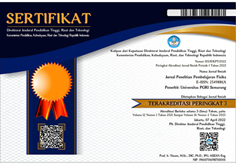Adaptation and Validation of the Indonesian Version of R.I.G.H.T. Leadership Scale
DOI:
https://doi.org/10.26877/asset.v7i4.2600Keywords:
health leadership, indonesian workers, scale adaptation, test validationAbstract
Leadership has a significant impact on organizational resilience and employee well-being. In accordance with International Test Commission guidelines, this study translated and validated the R.I.G.H.T. Leadership Scale for Indonesian employees. Online information was gathered from 302 workers from various industries (162 men and 140 women, ages 19–41). Psychometric testing, expert review, and forward-backward translation were all part of the adaptation. With over 90% expert agreement, the content validity was excellent (I-CVI and S-CVI = 0.99). A good model fit was found by confirmatory factor analysis (χ² = 136.65, df = 80, p <.001; RMSEA = 0.036; CFI = 1.00; GFI = 0.94). With slight declines ascribed to cultural and linguistic factors, reliability was high (α = 0.804–0.884). Despite its limitations, which include young samples and a lack of test-retest data, the Indonesian version is generally valid, dependable, and helpful for evaluating leadership practices.
References
[1] S. B. Harvey, S. Joyce, A. Johnson, H. Nguyen, M. Modini and M. Groth, “Developing a mentally healthy workplace: A Review of the literature,” Australian & New Zealand Journal of Psychiatry. 2017;51(12):108–118. https://doi.org/10.1177/0004867416672640.
[2] W. H. Organization, “World mental health report: Transforming mental health for all,” World Health Organization, 2022. [Online]. Available: https://www.who.int/publications/i/item/9789240063600. [Accessed July 17, 2025].
[3] K. Nielsen dan T. W. Taris, “Leading well: Challenges to researching leadership in occupational health psychology and some ways forward,” Work and Stress. 2019;33(2):107–118. doi:10.1080/02678373.2019.1592263.
[4] F. O. Walumbwa, B. J. Avolio, W. L. Gardner, T. S. Wernsing, and S. J. Peterson, “Authentic leadership: Development and validation of a theory-based measure,” Journal of Management. 2008;34(1):89–126. doi:10.1177/0149206307308913.
[5] W. H. Thomas, Ng, “Transformational leadership and performance outcomes: Analyses of multiple mediation pathways,” The Leadership Quarterly. 2017;28(3):385–417. https://doi.org/10.1016/j.leaqua.2016.11.008.
[6] S. Biricik-Gulseren, K. Robotham and J. Mistry, “R.I.G.H.T. Leadership: A new model for leadership in building mentally healthy workplaces,” Canadian Journal of Administrative Sciences. 2021;38(4):419–432. https://doi.org/10.1002/cjas.1640.
[7] L. G. Tummers dan A. B. Bakker, “Leadership and Job Demands-Resources Theory: A Systematic Review,” Frontiers in Psychology. 2021;12(7):1–13. https://doi.org/10.3389/fpsyg.2021.722080.
[8] G. Hofstede, Culture’s consequences: Comparing values, behaviors, institutions and organizations across nations(2nd ed.), Los Angeles: SAGE Publications.
[9] E. Lopper, K. T. Horstmann, dan A. Hoppe, “The Approach-Avoidance Job Crafting Scale: Development and validation of a measurement of the hierarchical structure of job crafting,” Applied Psychology. 2023;73(1):93–134. doi:10.1111/apps.12466.
[10] F. J. Van de Vijver and K. Leung, Equivalence and bias: A review of concepts, models, and data analytic procedures, Cross-cultural research methods in psychology, Cambridge University Press, 2011.
[11] I. T. Commission, “The ITC guidelines for translating and adapting tests (2nd ed.),” International Journal of Testing. 2017;18(2):101–134. https://doi.org/10.1080/15305058.2017.1398166.
[12] G. W. Cheung dan R. B. Rensvold, “Evaluating goodness-of-fit indexes for testing measurement invariance,” Structural Equation Modeling. 2002;9(2):233–255. https://doi.org/10.1207/S15328007SEM0902_5.
[13] T. L. Milfont dan R. Fischer, “Testing measurement invariance across groups: Applications in cross-cultural research,” International Journal of Psychological Research. 2010;3(1):111–121. doi:10.21500/20112084.857.
[14] X. Zheng, L. Graham dan C. I. Farh, “Cross-cultural measurement of servant leadership: A systematic review and future directions,” Leadership Quarterly. 2022;33(1):101–537. https://doi.org/10.21500/20112084.857.
[15] M. Kim dan T. A. Beehr, “Challenge and hindrance demands lead to employees’ health and behaviours through intrinsic motivation,” Stress and Health. 2018;34(3):367–378. doi: 10.1002/smi.2796.
[16] A. Stefana, U. Granziol, U. Provenzani, P. Solmi, E. A. Youngstrom, dan P. Fusar-Poli, “Psychological, psychiatric, and behavioral sciences measurement scales: Best practice guidelines for their development and validation,” Frontiers in Psychology. 2025;15:149–161. doi:10.3389/fpsyg.2024.1494261.
[17] S. Neufeld, S. M. Clair , P. Wilkinson, I. Goodyer dan P. Jones, “Measurement Invariance in Longitudinal Bifactor Models: Review and Application Based on the p Factor,” Assessment. 2024;31(4):774–793. doi:10.1177/10731911231182687.
[18] T. Oakie, N. Smith, J. Dimoff, and E. Kelloway, “Coworker health awareness training: An evaluation,” Journal of Applied Biobehavioral Research. 2018;23(4):1–14. doi: https://doi.org/10.1111/jabr.12148.
[19] A. J. Kaluza, F. Weber, R. Van Dick dan N. M. Junker, “When and how health-oriented leadership relates to employee well-being: The role of expectations, self-care, and LMX,” Journal of Applied Social Psychology. 2021;51(4):404–424. https://doi.org/10.1111/jasp.12744.
[20] D. Kohnen, H. De Witte, and W. B. Schaufeli, “Engaging leadership and nurse well-being: the role of the work environment and work motivation—a cross-sectional study,” Human Resources for Health. 2024;22(8). https://doi.org/10.1186/s12960-023-00886-6.
[21] W. Bank, “Indonesia Human Capital Development Report. Washington, DC: World Bank,” World Bank, Washington, DC, 2020.
[22] D. Polit, C. Beck and S. Owen, “Is the CVI an acceptable indicator of content validity?,” Res Nurs Health. 2007;30(4):59–67. https://doi.org/10.1002/nur.20199.
[23] J. K. Dimoff dan E. K. Kelloway, “Bridging the gap: Workplace mental health research in Canada,” Canadian Psychology. 2013;54(4):203–212. https://doi.org/10.1037/a0034464.
[24] R. Piccolo, R. Greenbaum, D. Hartog, dan R. Folger, “Ethical leadership and core job characteristics,” Journal of Organizational Behavior. 2012;31(3):259–278. doi: 0.1007/978-94-007-4059-416.
[25] F. F. Hasyim, H. Setyowibowo H dan F. D. Purba, “Factors contributing to quarter life crisis on early adulthood: A systematic literature review,” Psychology Research and Behavior Management. 2024;7(1):1–12. doi:10.2147/PRBM.S438866.
[26] K. Kelloway, Samantha dan J. Penney, Leading the Psychologically Healthy Workplace, New Jersey: John Wiley & Sons, 2017.











